Metal Roof Heat Cable Clip Cheat Sheet
Heat cables prevent ice dams that cause extensive water damage by melting channels through ice buildups, giving meltwater a clear path off your roof. When warm air in the attic melts snow on the roof and meltwater refreezes at cold eaves, it creates ice ridges that block drainage. This allows water to pool behind the dam and leak under roofing materials, potentially damaging interior walls and ceilings.
If you need to mount de-icing cable on corrugated metal, standing seams, snap-lock seams, R-panels, or flat panels, we have your solution. Here are the specific applications of our patented heat cable clips for different metal roofing systems, along with proper installation techniques and waterproofing methods.
Why Heat Cables Are Essential for Metal Roofs
Metal roofs are particularly susceptible to ice dam formation due to their thermal conductivity. Heat cables provide several critical benefits:
- Prevents water backup: Cables melt channels so meltwater drains away rather than pooling under roof panels
- Protects roofing and gutters: Prevents heavy ice ridges that can warp or tear off gutters and roof edges
- Guards interior walls: Stops meltwater from reaching interior ceilings and drywall, averting moisture damage
The extra weight and expansion of ice can bend or break gutters and roof edges, leading to structural damage. By maintaining open drainage pathways, heat cables protect both the roof structure and building interior from water damage.
Snow Retention Systems: A Critical Requirement
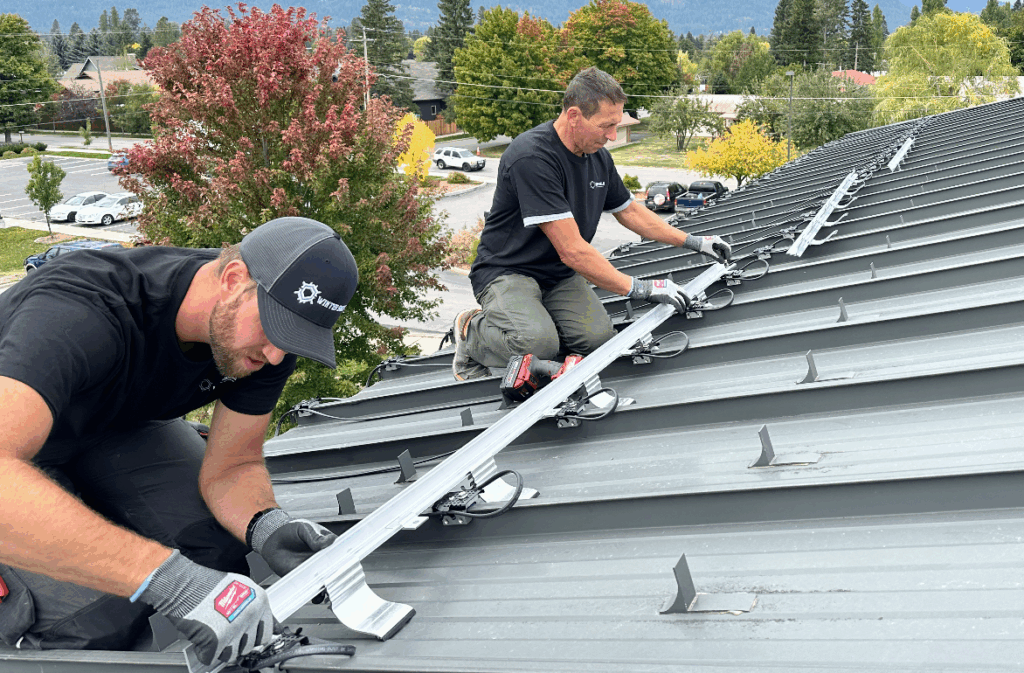
Always install snow guards or a snow fence above any heat cables. This isn’t optional – it’s essential for system longevity. Snow retention devices hold the snowpack on the roof so it melts gradually rather than sliding off in dangerous avalanches.
Without snow retention, large sheets of snow or ice can suddenly slide downhill with tremendous force, easily tearing heat cables and their clips off the roof. As noted by Warmzone, adding a snow retention system “helps prevent cable pull off that sliding ice can cause.”
| System Component | Function | Why It’s Needed |
| Snow Guards/Fence | Hold snowpack in place | Prevent snow avalanches that destroy cables |
| Heat Cables | Melt ice channels | Create drainage paths through trapped snow |
| Proper Clips | Secure cable positioning | Ensure cables stay in the correct melting position |
Most warranties require snow retention above heat tapes for this reason – omitting guards risks destroying your entire cable investment when snow avalanches occur.
Heat Cable Clip Applications by Roof Type
The following examples show heat cable installed in a repeating zig-zag or serpentine pattern along the edge of the roof, with specific clip solutions for each metal roofing system.
Corrugated and R-Panel Roofs
1. Corrugated Seam with JS-222 Clip
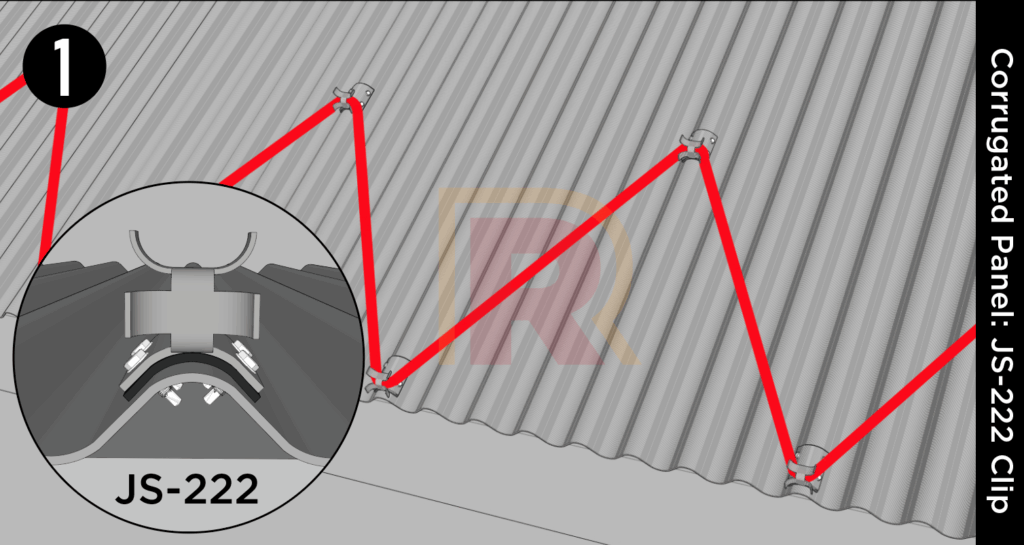
Installation Process:
- Position the clip on the high ridge of each corrugated panel
- Use included self-tapping screws with MKS butyl pads underneath
- Fasten through the clip to create a watertight connection
- Space clips approximately 24″ apart along each rib
6. Trapezoidal Panel with JS-222 Clip
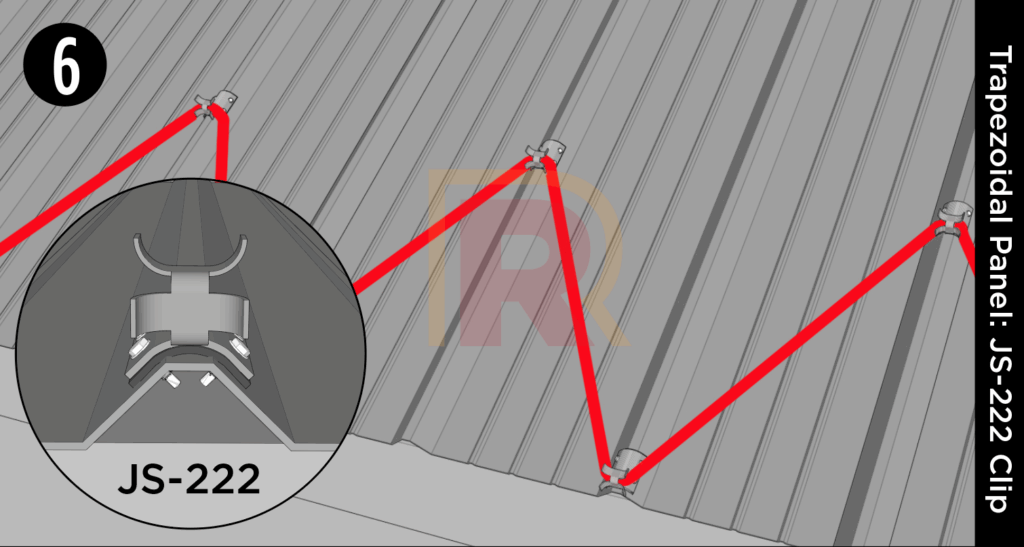
Standing Seam Roof Solutions
Standing seam roofs require specialized clips that grip the vertical seams without penetrating the roof surface. We offer multiple non-penetrating solutions:
2. Single Lock Seam with GVG Clip
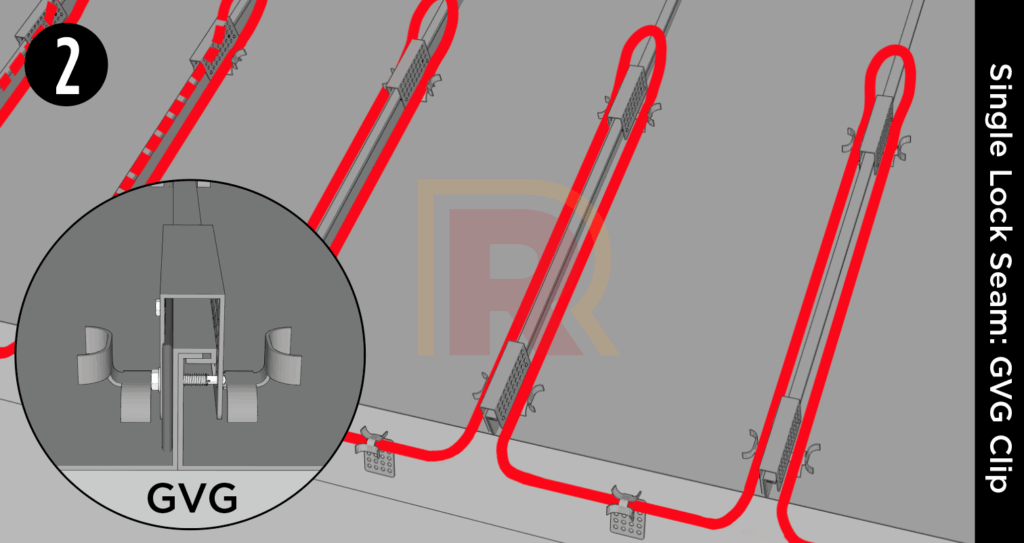
7. Standing Seam with GVG Clip (Alternative Application)
The GVG clip also works on standard standing seams by clamping onto the seam side, providing a strong attachment point whether installed with self-tapping screws or glued with SB-190 adhesive.
3. Standing Seam with LEO-215 Clip
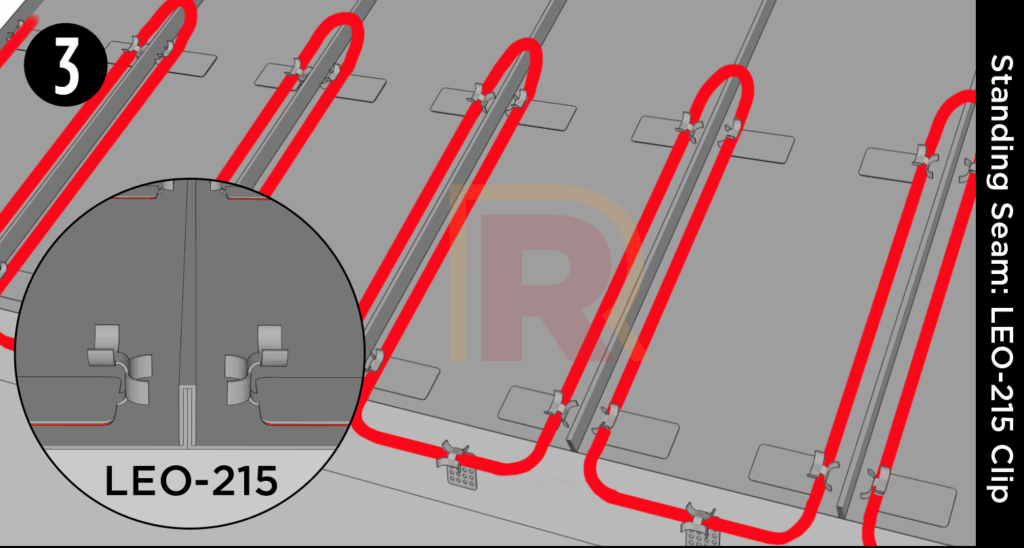
Installation Benefits:
- Clean the surface and stick the clip directly to the seam panel
- Holds cable up to 30 lb in any weather conditions
- No penetrations required, preserving roof warranty
4. Standing Seam with S5-SR Clip
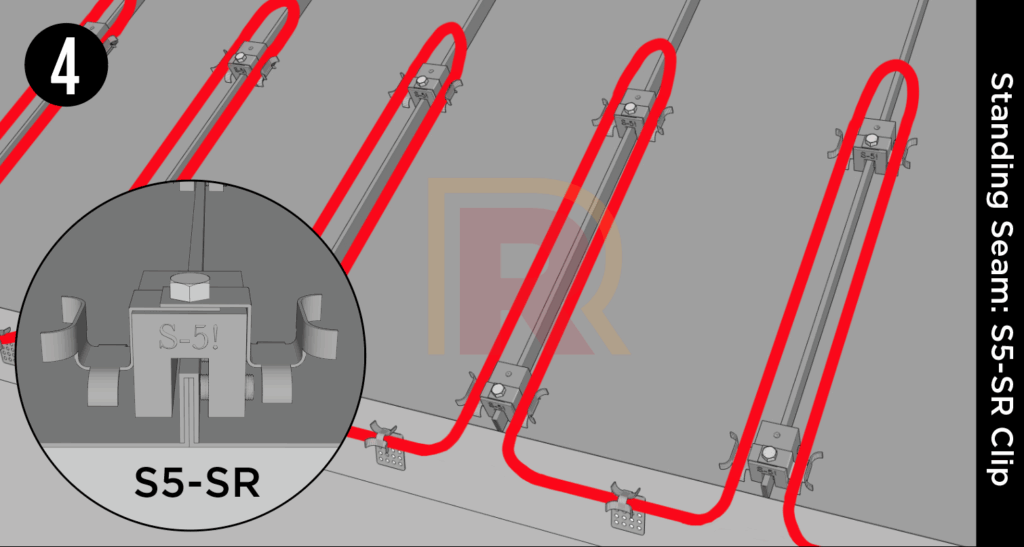
The S5-SR clip attaches to the top of a standing seam using the S-5 base clamp system. This engineered solution provides maximum holding strength without roof penetrations.
System Components:
- S-5 base clamp (non-penetrating bite on seam ridge)
- S5-SR clip that bolts onto the base clamp
- Positions cable precisely at the seam ridge for optimal melting
As described in our technical documentation, the S5-SR is “designed to securely attach heat tape to standing seam roofs in conjunction with the S-5 base clamp, holding heat cable in the correct position without adhesives, nails, or screws penetrating your roof.”
Specialty Seam Applications
5. Snap-Lock Seam with DDK-1 Clip
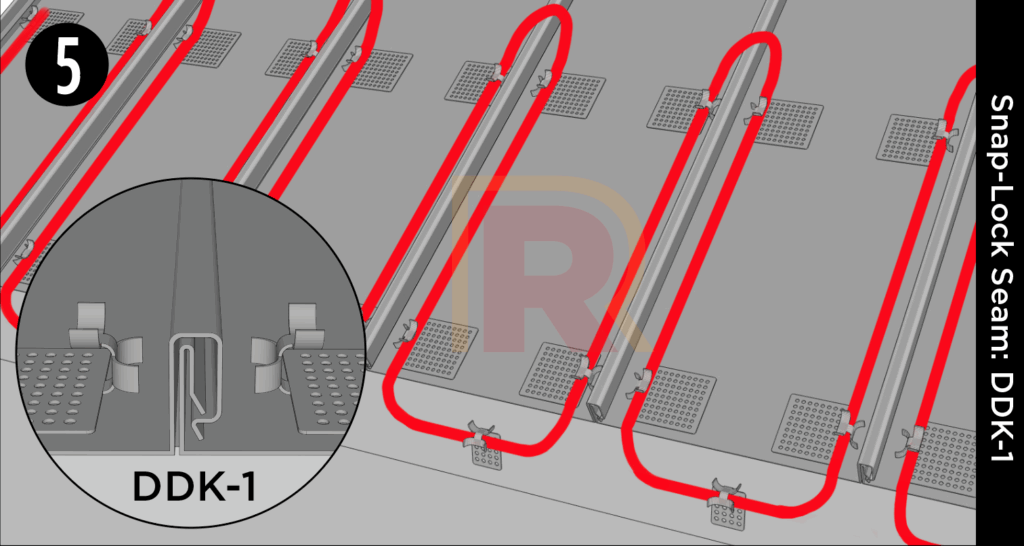
The DDK-1 clip is inserted into the seam of a snap-lock roof panel to secure the heat cable. Snap-lock roofs with hidden, interlocking seams require this spring-type clip design that hooks onto the folded seam itself without external fasteners.
8. Batten Seam with DDK-1 Clip
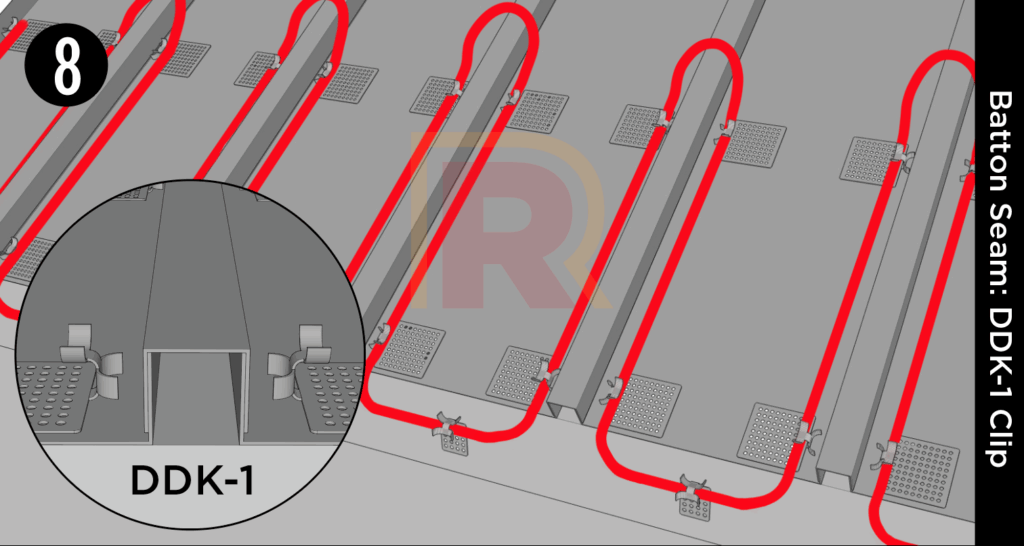
How Hot Do Heat Cables Get?
Our self-regulating heat cables operate at much lower temperatures than many people expect – typically between 40°F to 90°F, depending on ambient conditions. This is barely warmer than your body temperature and far safer than constant wattage alternatives.
Temperature Characteristics:
- Peak operating temperature: 60°F-85°F in cool environments
- Self-regulating technology: Cable adjusts heat output based on surrounding temperature
- Safe for all surfaces: Won’t damage metal, plastic, or rubber roofing materials
- Overlap-safe: Can touch itself without risk of overheating or fire
As one customer noted about our heat cable temperature: “It creates enough warmth to effectively do its job, but won’t do damage to surfaces that it touches.” This gives our Heat Tape PRO a significant safety advantage over constant wattage heat tape found in big-box retailers, which can create fire hazards if overlapped or coiled.
Waterproofing Fastener Locations
Proper sealing is crucial where clips penetrate or adhere to the roof. Every screw penetration must be properly sealed to maintain your roof’s watertight integrity.
For Screwed Clip Applications:
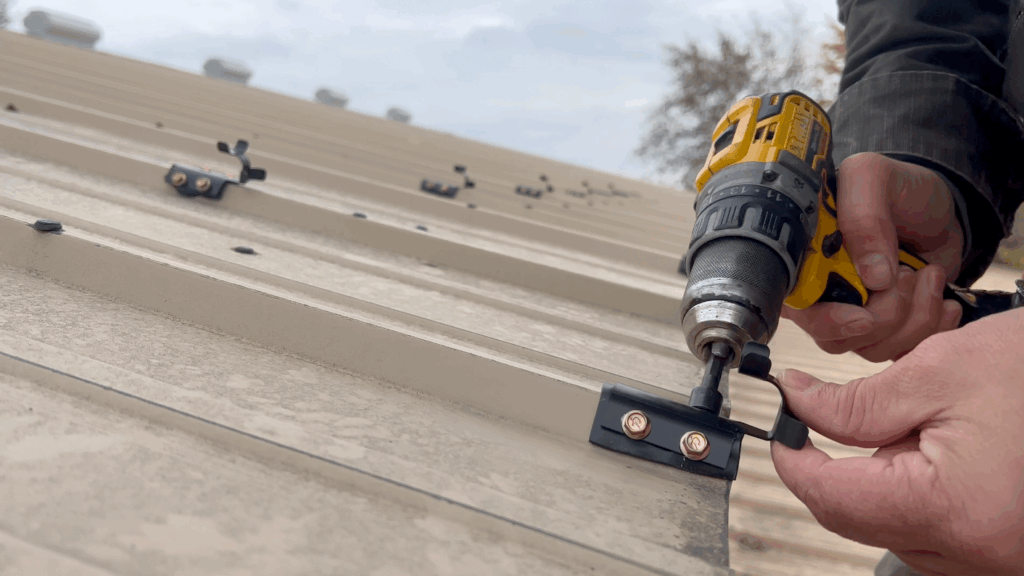
When compressed by the clip and screw, MKS-1022 butyl pads form a permanent watertight gasket. For example, installing a GVG clip with screws and an MKS-1022 pad “will create a watertight connection between the clip and the standing seam.”
For Adhesive Clip Applications:
We recommend SB-190 adhesive for all ‘glue-down’ heat cable clip applications, such as LEO-215 clips and DDK-1 clips on batten seams. This high-strength, instant-grab adhesive creates a lifetime waterproof seal under each glued clip.
Waterproofing Products:
| Product | Application | Seal Type |
| MKS-1022 | Under all screwed clips | Butyl rubber gasket |
| SB-190 | Under all glued clips | Weatherproof adhesive bond |
By combining mechanical attachment with these proven sealants, your heat cable system remains fully waterproof throughout its operational lifetime.
Clip Selection Guide by Roof Type
| Roof Type | Recommended Clip | Attachment Method | Key Benefits |
| Corrugated Metal | JS-222 | Screws + butyl pads | Matches curved rib profile |
| R-Panel/Trapezoidal | JS-222 | Screws + butyl pads | Fits flat raised ribs |
| Standing Seam | GVG, LEO-215, or S5-SR | Adhesive or clamp | Non-penetrating options |
| Snap-Lock | DDK-1 | Glue onto seam | Non-penetrating |
| Batten Seam | DDK-1 | Glue to roof | Adapts to batten profile |
Professional Installation vs. DIY
Approximately 50% of our customers install heat cable systems themselves, while the other half work with professional installers. The choice depends on roof complexity, comfort with heights, and local building codes.
When to Consider Professional Installation:
- Complex roof geometries with multiple valleys or dormers
- Roofs higher than two stories
- Local codes requiring electrical permits
- Standing seam systems requiring precise seam clamp placement
DIY-Friendly Applications:
- Simple gable roofs with standard eaves
- Corrugated or R-panel systems with straightforward clip attachment
- Homeowners comfortable with basic roof work and electrical connections
Product Links and Resources
Heat Cable Clips:
Installation Resources:
- Have a unique metal roof? Use Our Heat Cable Calculator
- Don’t see your clip? View our entire clip selection
- Need professional help? Find a Heat Tape Installer
Get Expert Help for Your Metal Roof Project
Choosing the right clip system for your specific metal roof ensures reliable ice dam prevention that lasts for years. Our team has over 35 years of experience solving ice dam problems and can help you select the perfect solution for your roof type and local climate conditions.
